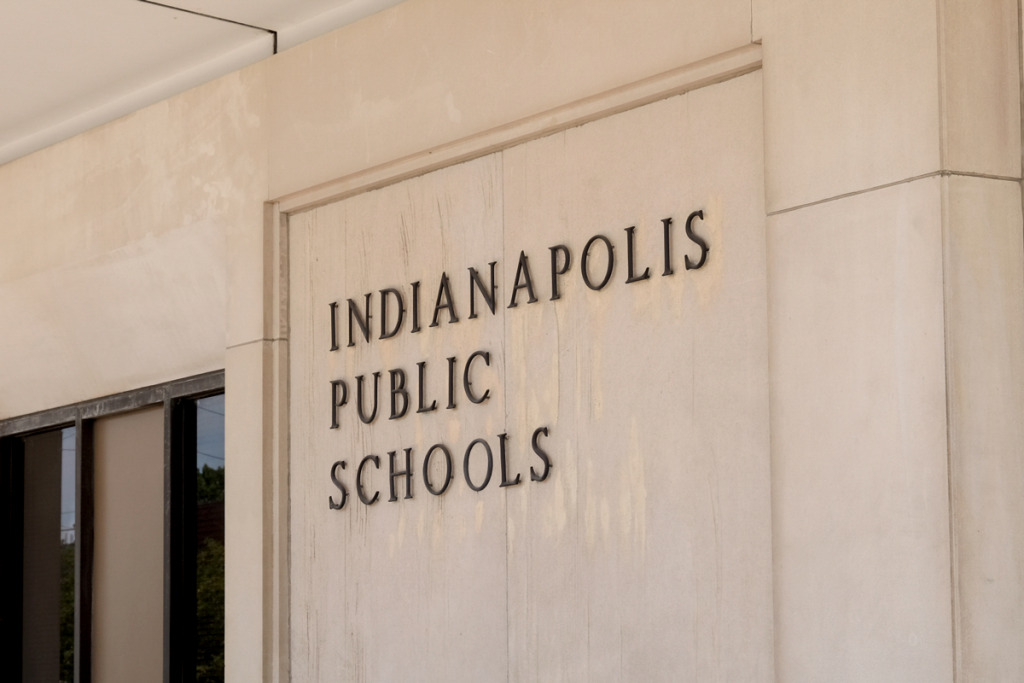Subscriber Benefit
As a subscriber you can listen to articles at work, in the car, or while you work out. Subscribe NowThis story was originally published by Chalkbeat Indiana.
Indianapolis Public Schools faces competition on nearly every street corner.
“Vouchers accepted,” read signs for a private Christian school strewn throughout the Fountain Square neighborhood.
“Now enrolling!” signs for multiple charter schools beckon in Mapleton-Fall Creek.
“Free college in high school,” touts one charter school on the east side.
In short, IPS is fighting for students—and the state funding that follows them—as local charters and private schools continue to grow. And students have been leaving the school system in droves. So, as IPS spent millions of dollars of federal COVID relief on high-profile priorities like academic recovery and staff retention, it also directed some of that aid to a different goal: enticing students back to the district, with the help of a private company.
The $269,600 the district paid to the Memphis-based Caissa K-12 firm to recruit and retain students as of March 31 is less than 1% percent of the district’s $217.2 million in COVID relief money. But the effort highlights the district’s ongoing challenge with long-term declining enrollment that worsened during the pandemic. At its worst, roughly one out of 10 IPS students left the district from 2019-20 to 2020-21.
Meanwhile, charter school enrollment within and near IPS borders has grown almost every year—as has the number of IPS students attending private schools using state-funded tuition vouchers, which lawmakers expanded this year.
Ultimately, IPS is relying heavily on its Rebuilding Stronger plan to improve academic offerings and school facilities as a strategy to attract families to the district.
Caissa K-12 President Adrian Bond said the firm works with traditional public school districts on marketing themselves to parents—something charter schools, private schools, and homeschool networks have done a better job of in years past.
“Districts have to realize this is almost like a business now,” he said. “You’re not the only business in town anymore.”
IPS says the money spent on Caissa K-12 helped a student recruitment campaign that brought nearly 400 students into IPS through a contract that lasted for the 2021-22 and 2022-23 school years. But raising even a small portion of federal relief funds this way could raise questions.
“From my perspective, I’m seeing so many other compelling needs in terms of supporting student development,” said Thomas Dee, professor at Stanford University’s Graduate School of Education who has tracked student enrollment declines from the pandemic. “It’s difficult to look at that expenditure and characterize it as the best available use of scarce funds.”
For several years before COVID hit, IPS lost between 3% and 4.4% of its enrollment annually. But between the 2019-20 and 2020-21 school year, that loss jumped to 10.5%.
After COVID shut schools down and ushered in virtual learning at the end of the 2019-20 school year, IPS decided to open the 2020-21 school year virtually. Such a decision may have had a significant impact on the district’s enrollment.
Schools that offered remote instead of in-person instruction saw a decline in enrollment, particularly in kindergarten and elementary grades, according to research Dee and others conducted using data from across the country.
Meanwhile, charter school enrollment within IPS borders grew from roughly 7,500 students in 2018-19 to over 9,400 in 2022-23. The number of students who live within IPS borders but use vouchers to attend private schools has also grown steadily from roughly 3,580 students in 2017-18 to roughly 4,240 in 2022-23.
Now, many districts have settled into a new equilibrium with fewer students, Dee said. They also face financial pressure to close under-enrolled schools, once federal COVID relief expires and districts face a fiscal cliff.
“Part of the critical narrative going forward isn’t so much that the exodus has stopped,” Dee said, “but rather that the kids haven’t returned.”
The district worked with Caissa K-12 to launch a student retention campaign that focused on contacting families who had previously been enrolled in an IPS school, the district said in a statement. The IPS contract with the company lasted from May 2021 through June 2023.
The campaign reached out to families through text, email, and phone calls. The campaign focused on understanding why students left the district, and highlighting the programs that the district has to offer, Bond said.
“There’s a lot of other educational options out there that parents may see as the shiny and bright toy, and then they just don’t realize that they have similar or better programs at the traditional public school,” Bond said. “But oftentimes the traditional public schools do not have the ability to be able to put that out at a grassroots level.”
Caissa’s work requires anywhere from nine to 22 contacts with parents in order to get them to return, Bond said.
Caissa K-12 and its affiliated Memphis-based communications firm, Caissa Public Strategy, have worked with districts across the country. Since the pandemic hit, Caissa has scored contracts to recruit students with Florida’s Duval County Public Schools, which includes Jacksonville, and Louisiana’s Jefferson Parish Schools, the largest district in the state.
And in March, the Metropolitan School District of Washington Township approved a contract with Caissa K-12 for customer service training, a student recruitment campaign at $953 per student, and $31,200 in “secret shopper” campaigns, in which the firm poses as a family interested in attending the district and provides feedback on the school staff’s response.
“Spending time and resources on recruiting and retention became necessary after Covid-19 when we noticed that a number of students were not returning to school,” a spokesperson for Washington Township schools said in a statement.
Caissa’s website frames student recruitment in terms of customer service, offering secret shopper evaluations, training, and other services “exclusively for public schools.”
Caissa isn’t afraid to be blunt when marketing its services. The firm advertises itself with phrases such as “Sick of screaming parents?” and “The customer is not always right! But we sure do need them.”
Asked about Caissa’s use of that language, Bond said the company works with districts to make sure their front desk workers and registration teams put their best foot forward to parents. The group trains staff to advocate for the goal they are trying to accomplish and emphasize how it benefits the students and parents at the end, he said.
IPS did not use Caissa’s training services. But the district said that the campaign recruited nearly 400 students into the district. At the start of this school year, Superintendent Aleesia Johnson said IPS enrollment was similar to last year’s figure of just over 22,000 students.
IPS believes its contract with the firm brought “significant additional revenue for the district,” but did not specify how much. Basic state per-pupil funding was about $6,000 in 2021-22, and $6,234 in 2022-23.
But Bond said Caissa’s work should be just one part of districts’ efforts to stem declining enrollment.
“It is only a Band-Aid,” he said. “What we’ve seen is districts need to make this part of their overall strategy for the stabilization of enrollment. We help recruit students in the front doors, but also districts have to figure out ways to retain those students from leaving out the back door.”
The district said in its statement that its work with Caissa inspired it to build its own recruitment and retention team. As of March, the district had spent about $5,400 more in pandemic relief funds to do so.
Dee, however, said such recruitment campaigns aren’t a “scalable solution for academic recovery.” He also said that amidst many acute challenges schools now face, such efforts have limited value because they’re “chasing a fixed population of students.”
“I bristle at the idea of simply trying to market yourself better to attract kids,” he said. “Because from a broader policy perspective, it’s robbing Peter to pay Paul.”
Chalkbeat Indiana is a not-for-profit news site covering educational change in public schools.
Please enable JavaScript to view this content.


